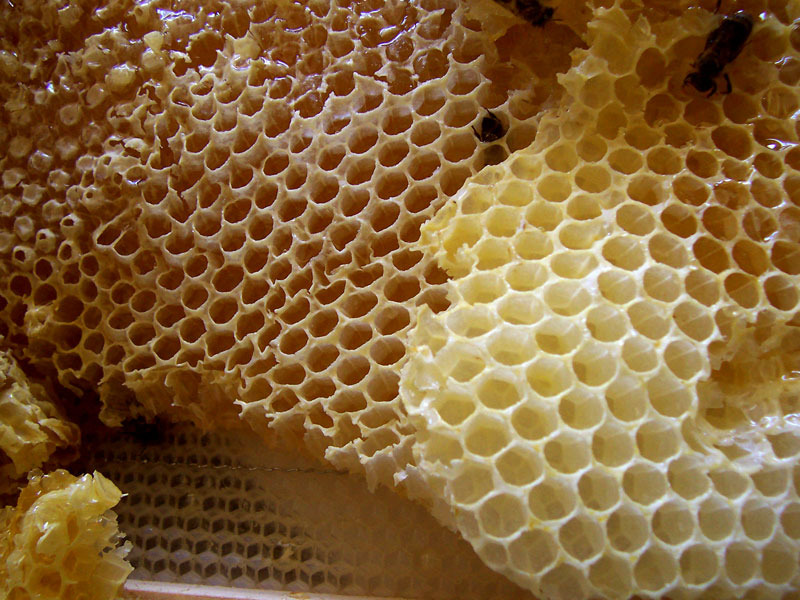Harvest honey
Observe and harvest honey safely with adult supervision and protective gear: inspect a hive, remove frames, uncap comb, then spin or strain honey to taste.



Step-by-step guide to harvest honey safely
Beekeeping 101: HOW TO HARVEST HONEY | Every step explained for beginner beekeepers!
Step 1
Put on your protective gear with an adult helping you to zip and fasten everything.
Step 2
Choose a calm sunny time of day to work with the hive when bees are usually gentle.
Step 3
Ask the adult to operate the smoker at the hive entrance to calm the bees.
Step 4
Use the hive tool to gently pry off the hive top and inner cover.
Step 5
Lift one frame straight up and hold it vertical to look for fully capped honey cells.
Step 6
Ask the adult to hand you a fully capped honey frame and place it in your clean tray.
Step 7
Gently brush any remaining bees back into the hive using the bee brush or give a small shake over the hive.
Step 8
Replace the other frames and close the hive top securely when you are done inspecting.
Step 9
Hold your capped frame over a bowl and use the uncapping knife or fork to remove the wax caps.
Step 10
Place an uncapped frame into the extractor basket if you have an extractor.
Step 11
Ask the adult to slowly spin the extractor so honey comes out of the frames into the bucket.
Step 12
If you do not have an extractor cut the comb into a clean bowl and pour it through cheesecloth or a fine strainer into a jar.
Step 13
Pour the strained honey into clean jars and seal the lids tightly.
Step 14
Ask the adult to check the honey for safety and then taste a small spoonful if it looks good.
Step 15
Share your finished honey harvest on DIY.org
Final steps
You're almost there! Complete all the steps, bring your creation to life, post it, and conquer the challenge!


Help!?
What can we use if we don't have the exact tools like an extractor, uncapping knife, or bee brush?
If you don't have an extractor or uncapping knife use the instruction 'If you do not have an extractor cut the comb into a clean bowl and pour it through cheesecloth or a fine strainer into a jar' and substitute a clean fork (already mentioned) and a soft paintbrush or feather for the bee brush.
What should we do if bees won't leave the frame or get agitated while we harvest?
If bees stay on the frame, follow the steps to 'Ask the adult to operate the smoker at the hive entrance' again and 'Gently brush any remaining bees back into the hive using the bee brush or give a small shake over the hive' while holding the frame vertical.
How can this activity be adjusted for different ages so it's safe and fun for everyone?
For younger children let them do safe jobs like 'place it in your clean tray' and 'hold your capped frame over a bowl' while adults handle the smoker and tools, and for older kids let them 'use the uncapping knife or fork' and 'place an uncapped frame into the extractor basket' under adult supervision.
How can we extend or personalize the harvest after we've poured honey into jars?
After you 'pour the strained honey into clean jars and seal the lids tightly,' save the wax caps to make beeswax candles and create decorated labels to share your finished honey harvest on DIY.org.
Watch videos on how to harvest honey safely
Learn About Bees & Honey for Kids | Pollination & Beekeeping | Educational Video for Kids
Facts about beekeeping for kids
🍯 A healthy hive can produce roughly 30–100 pounds (14–45 kg) of extra honey a year in a good season.
🕰️ Archaeologists have found pots of honey in ancient Egyptian tombs that were still edible after thousands of years.
🔥 Beekeepers puff mild smoke into a hive because smoke masks alarm signals and helps calm the bees.
🐝 The waggle dance is how forager bees show other bees the direction and distance to flower patches!
🥽 Wearing a bee suit, veil, and gloves greatly reduces stings and keeps both kids and bees safer during harvests.
How do I safely observe and harvest honey with my child?
What materials and equipment do we need to harvest honey at home?
What ages are appropriate for children to participate in honey harvesting?
What safety tips and benefits should parents know about child honey harvesting?


One subscription, many ways to play and learn.
Only $6.99 after trial. No credit card required



